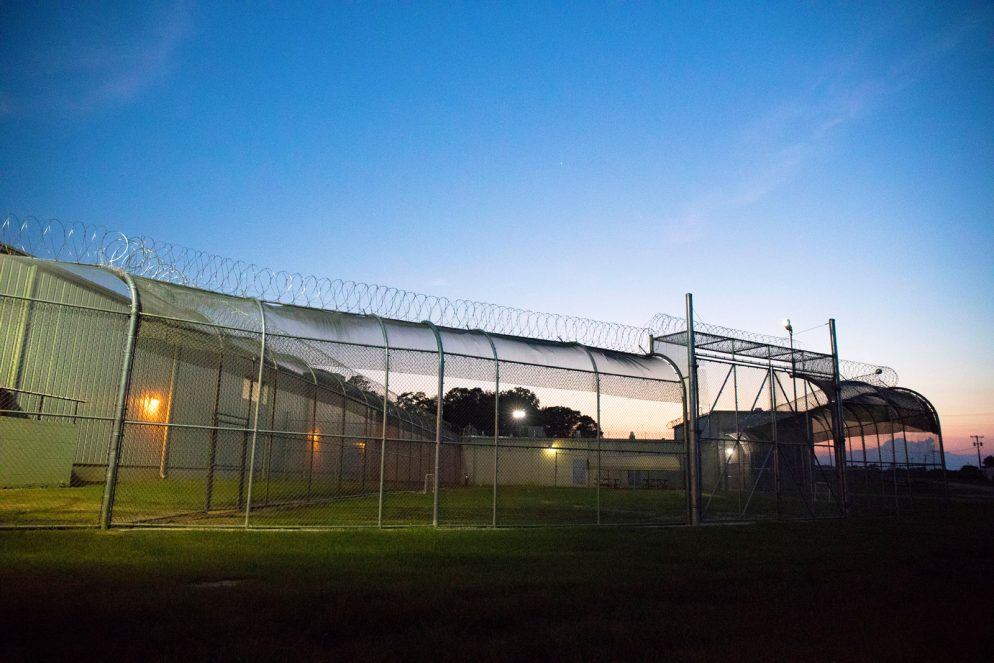Navigating the Immigration System in Southern Georgia
After a year of planning, Associate Professor and Chair of the Sociology Department Eric Popkin took 10 CC students to Georgia to help support attorneys working in three immigrant detention centers served by the Southern Poverty Law Center. The students, all highly proficient or native Spanish speakers, spent May 25-June 9 working with the center’s Southeast Immigrant Freedom Initiative. There they served as legal assistants conducting background interviews and research specific to immigrant detainee cases.
Veronica Fernandez Diaz ’19, Elam Boockvar-Klein ’20, Grace Cooke ’19, and Manny Meraz ’19 worked at the Stewart detention center in Lumpkin; Miguel Mendez ’19, David Eik ’19, and Asha Rudrabhatla ’20 worked at the Irwin detention center in Ocilla; and India Hilty ’20, Mark Scaggs ’18, and Bella Smith ’20 worked at the Folkston detention center in Folkston.
From the Classroom to the Southern Poverty Law Center
By Eric Popkin, Associate Professor and Chair of the Department of Sociology

Since arriving at CC, Eric Popkin has taught Globalization and Immigration on the U.S.-Mexico Border, a class that examines immigration dynamics and policy in the border region. Recent iterations of the course have focused on the increasing criminalization of immigration policy, including the rapid dependence on immigrant detention. As part of the course in 2016-17, students worked for a week in the family detention center in Dilley, Texas, conducting credible fear interview preparations with Central American women in detention with their children. Some of those students also participated in this summer’s SPLC work with the Southeast Immigrant Freedom Initiative.
The shocking news of migrant children from Central America being taken away from their parents upon arriving at the U.S.-Mexico border due to the Trump Administration’s new “zero-tolerance policy” brings me back to 1983. I was working in a migrant shelter in Southern Texas supporting thousands of traumatized Central American refugees fleeing U.S.-backed government-sponsored repression in the region. These “refugees” were considered economic migrants by the Reagan Administration and denied asylum — to award this status would admit complicity in supporting the government violence that generated the refugee flow.
After years of pouring millions of dollars into military aid to the governments of El Salvador, Guatemala, and Honduras (so called Northern Triangle of Central America) in the 1980s and ’90s, the U.S. government failed to provide financial assistance and contribute to post-war rebuilding efforts. Direct support for neoliberal economic policies and assistance to corrupt officials facilitated a context enabling brutal remnants of security forces to maintain power in post-war society, fueling community-level gangs and drug trafficking in the post-war era. Since then, thousands of migrants have been fleeing gang-related violence and generalized violence against women in the region. Family detention of these “refugees” (while they pursued credible fear interviews as the first step in an arduous asylum process) accelerated under the Obama Administration and set the stage for the recent policy change leading to criminal prosecution of any adult who has crossed the border without authorization (formerly a civil offense). Under this policy, children entering with these adults have been considered “unaccompanied alien minors” and are taken away from their parents and transferred to the Office of Refugee Resettlement, which operates under the Department of Health and Human Services. Due to the public uproar and court decisions requiring the ending of these family separations, the Trump Administration, as of press time, has shifted to a strategy of rapid expansion of family detention centers. These changes occur alongside efforts to dramatically restrict the right to apply for asylum even for those migrants who present themselves at border checkpoints and profess a credible fear to return to their home country.
Over the past 10 years, Central American migration has surged while Mexican migration has decreased, and the number of immigrants apprehended in the interior of the country has grown dramatically. The U.S. Congress has expanded the mandatory detention of immigrants to unprecedented levels, leading to long-term jailing of people with pending immigration cases. Because of the increasing backlog in immigration court and the already lengthy process, people spend years in harmful and costly detention centers. Two laws passed in 1996 under the Clinton Administration, the Antiterrorism and Effective Death Penalty and the Illegal Immigration and Immigrant Responsibility Act, contributed to the explosion of immigrant detention. These laws categorized a huge range of crimes as “aggravated felonies” in the immigration context, many of which are considered neither aggravated nor felonies in the criminal context. The term has remained vague, allowing courts to reinterpret and broaden its meaning facilitating the expansion of immigrant detention. Many immigrants, including legal permanent residents, have been apprehended for minor offenses committed years ago given the priority placed on interior enforcement by both the Obama and Trump administrations. Currently, more than 34,000 immigrants are detained at any given time. The Trump Administration has asked Congress for $2.7 billion to increase the number to 52,000 — a level that would result in approximately 430,000 immigrant detentions in a fiscal year.
Over 60 percent of immigrant detention centers are privately run, with GEO and CoreCivic being the largest companies operating these centers. They subcontract services such as food, phone, laundry, health services, etc.; thus, the profit motive encourages minimizing costs as much as possible. Counties and localities vie for these contracts: They are paid up to $150/day per detained immigrant and the centers provide some of the only jobs in the remote areas prioritized as detention center locations. The remoteness also means that detainees are often unable to access lawyers to represent them. Immigrants with legal counsel are more than 10 times as likely to succeed in their cases as those without a lawyer. Only one in six immigrants detained in the Southeast has access to an attorney in removal proceedings. These proceedings will determine whether they have a right to remain in the United States.
In order to help increase the capacity of attorneys representing detained immigrants, I began conversations with the Southern Poverty Law Center a year ago to explore possibilities for highly proficient Spanish-speaking Colorado College students to assist legal teams working in the U.S. Southeast. This region of the country is notorious for some of the worst conditions in detention centers and extremely restrictive immigration courts that deny bail and reject asylum claims more than 90 percent of the time. The SPLC Southeast Immigrant Freedom Initiative aims to safeguard due process by providing high-quality, pro bono legal representation to detained immigrants. They operate at four immigrant detention centers in the Deep South — three in Georgia and one in Louisiana. A critical component is the recruitment of volunteer attorneys and trained volunteers to support the legal teams. Attorneys, interpreters, and law students, with faculty supervision, spend time at one of SIFI’s four immigrant detention centers, Stewart, Irwin, LaSalle, and Folkston. Volunteers may participate in immigration court hearings to seek clients’ release, conduct visits with clients, and screen potential clients for representation.
To my knowledge, Colorado College is the only undergraduate institution in the United States that has established this kind of relationship with the SPLC for group work in support of the SIFI initiative.
The Department of Sociology initiated this program because of our interest in creating new community-based learning and research experiences that highlight activism and advocacy work aimed at confronting racialized oppression and promoting racial and economic justice in a context in which democratic institutions are threatened in the United States. We also want to offer practical, skill-based educational and community-based research experiences with diverse populations. This program offers training to students interested in public interest legal careers focused on immigration. The Department of Sociology provided partial or full funding for each of the students participating in the program and will work with the college to secure funding to continue the program in subsequent years, and the Office of Field Study provided logistical support.
Their Story to Tell: Excerpts from Students’ Journals About Their Time Working in Georgia
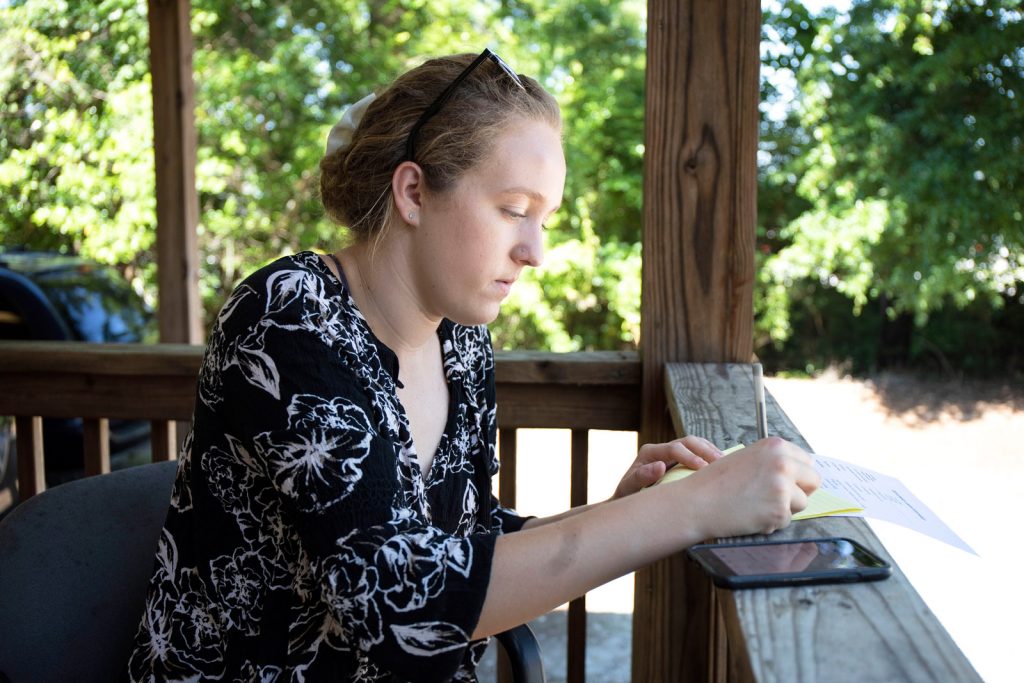
Grace Cooke ’19
I’m a little anxious to start, especially because I won’t have a technological outlet for the full two weeks.Not having my phone/computer/wi-fi will make these next couple of weeks that much harder, but I’m hoping it will give me an opportunity to fully invest myself into this project and my team. Also, Lumpkin is actually in the middle of nowhere. You can drive the town in less than two minutes, and it is clear that it is a very poor, rural area of Georgia, with the residents mostly being people of color. Already the environment is giving me some red flags about what we are going to be seeing in the detention center. — Grace Cooke ’19, Stewart Detention Center, Lumpkin
People detained in the Southeast United States arguably had the steepest hill to climb in terms of gaining asylum. In this region of the U.S., judges are granting asylum at lower rates than anywhere else in the country — the average is approximately two percent in Atlanta courts in comparison to 84 percent in New York and 74 percent in San Francisco. — India Hilty ’20, Folkston Detention Center, Folkston
What a depressing place. I went for a walk today just to get a sense for the streets, the houses, the people. All I saw were broken-down sidewalks, abandoned homes, empty storefronts, and a few people wandering aimlessly down the streets. The liveliest place in the whole town is the detention center itself. And it is lively for all of the wrong reasons. Stewart staff conversing lightheartedly barely greet you as you walk in. People in uniforms walk in every which direction. Rooms are at least painted, inhabited, and frequented. But aside from its liveliness, or maybe because of it, its cruelty is also present. Migrants have barely any access to legal help, and it has been described as a modern-day concentration camp. You can’t bring in a single reading material to pass the time. Bathrooms are virtually unavailable. Detainees must be communicated to through a telephone — you can’t even shake their hands; family members can’t feel the touch of their loved ones. — Elam Boockvar-Klein ’20, Stewart Detention Center, Lumpkin
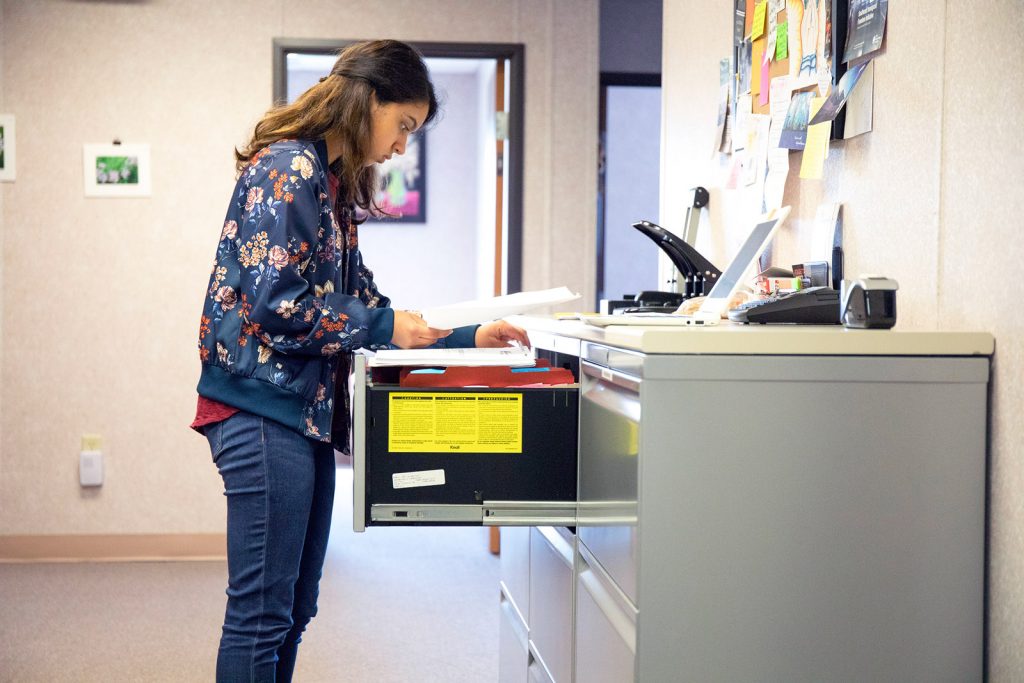
Asha Rudrabhatla ’20
The Irwin County Detention Center is no home in any sense of the word. It is neither a temporary nor permanent residence. It is not a “residence” at all. It is a place that is hostile to detainees and to the attorneys who fight for their freedom. There is only one attorney-client visiting room for 1,201 detained persons. When it is occupied (which it often is), we wait. We wait for hours. When the room finally does become available, sometimes we have to wait an additional hour until “count” ends. And when we finally do get into the room, we and the detainees are locked in from the outside until the security guard unlocks the door using a switch located behind a one-way mirror that overlooks the visiting room. — Asha Rudrabhatla ’20, Irwin Detention Center, Ocilla
My first few days here began with the case of J., a teenager from Honduras who is currently detained after escaping his country for fear of gangs, who had killed his brother. Today, J. was denied his application for bond. It was horrible to see how the judge’s ruling completely devastated J. as well as the lawyers who spent days devoting themselves to his asylum claim. In this sense, I believe I have seen the two sides of immigration law. On the one hand, the lawyers and many remote workers dedicated countless hours contacting J.’s family, the American family who was going to serve as J.’s sponsor, and other people who could reinforce his claim to be released on bond with a letter of support. On the other, this vast amount of time seemed insignificant when the immigration judge simply repeated the same line of argument forwarded by the federal prosecutor. There was certainly sadness and disappointment on behalf of J., but also a distinct sense of frustration for the seemingly random nature of being assigned to a judge who has yet to grant a bond in one of the strictest parts of the country. — Mark Scaggs ’18, Folkston Detention Center, Folkston
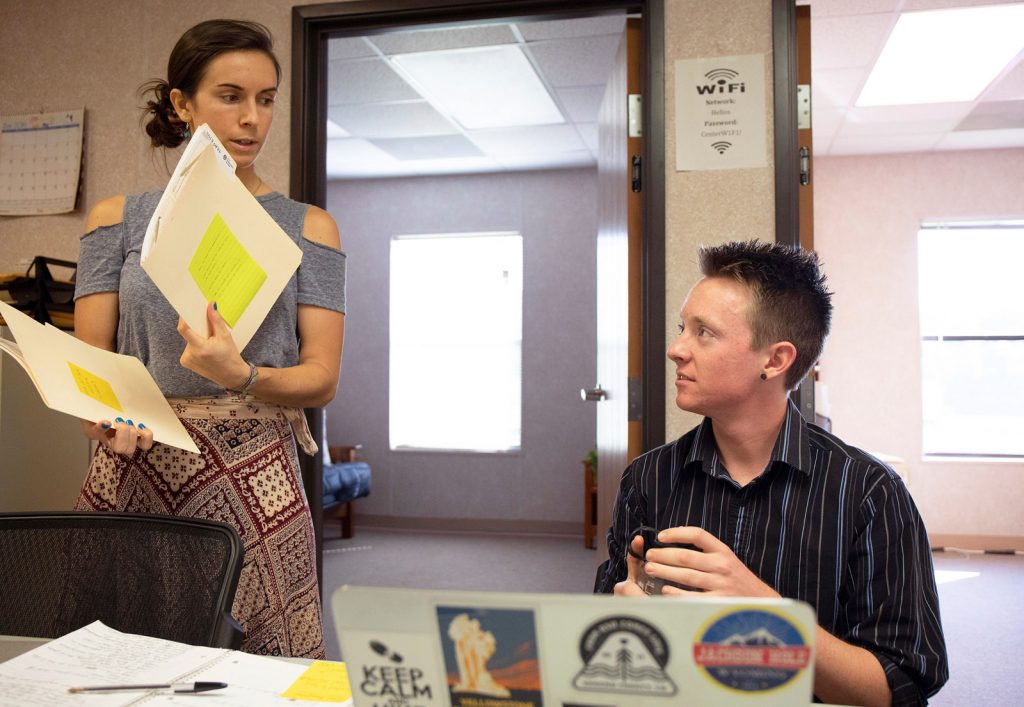
SPLC worker and David Eik ’19
I tried to complete my first video-call screening with a woman from the Congo who spoke French and had previously applied for asylum. This was by far the most frustrating part of the experience so far. We spent the first 30 minutes of the meeting troubleshooting the issues we had connecting via Skype and connecting a three-way call with the interpreter. However, after figuring out that it was best to do a three-way call with the interpreter and just use Skype to see her face, we were on our way. Interviewing someone with an interpreter is quite difficult. Everything takes twice as long as it normally would, and it’s super difficult, if not impractical, to ask follow-up questions in many cases. We made it through about a third of the interview before the time for the interpreter was up, so we had to end the interview and reschedule another one to finish it. — David Eik ’19, Irwin Detention Center, Ocilla
After lunch, I stayed in the office to help start a document for detainees who recently got a bond. I wasn’t too familiar with the process, so I was learning along the way, but the number of obstacles and requirements for paying a bond are outlandish and tedious. Bonds can’t be paid in cash, so they need to be paid in money orders or cashier’s checks. For someone who has legal status in this country, this might be simple, but for someone who doesn’t fully understand English and has limited resources, the process can be daunting. We contacted banks and local post offices around the U.S. to find out what sort of documents and forms of identification are needed to obtain money orders and cashier’s checks. Every institution had different requirements, and some contradicted each other making the process that much more confusing to navigate. What really stuck out as problematic for me was the process needed to go pay the bond once the secure form of payment was acquired. We tried to call at least 12 different ICE offices to continue our research and we were only able to get in contact with one of them. Most offices close at 4 p.m. or earlier, limiting the time that people have to handle their business with the immigration office. In order to pay a bond, one must set up an appointment and have multiple documents to prove that they are the family member of the person for whom they are paying the bond. Put yourself in an immigrant’s shoes who doesn’t have the same resources we had to call multiple offices and stay on hold to see if we could finally talk to somebody. A majority of these people would have to take a day off from work to go to one of these offices to meet with immigration to pay the bond and that is a hard sacrifice for them because they already have limited resources. — Miguel Mendez ’19, Irwin Detention Center, Ocilla
It’s 10:20 a.m. In 10 minutes, “count”* will start. In 10 minutes, we, along with the detainees we are meeting, will be locked in the single attorney-client visiting room. Should count start when we are in that room, we must stay there for the next hour, or even longer. As an attorney from the Southeast Immigrant Freedom Initiative of Ocilla told us, detainees are subjected to this cumbersome process a shocking (and incredibly unnecessary) five to seven times each day. — Asha Rudrabhatla ’20, Irwin Detention Center, Ocilla
One man at Folkston told me that he works in the kitchen from 3-11 a.m. and gets paid $2.50 per day. It costs him 43 cents per minute to call his brother in Nigeria. How can someone gather support letters or find legal representation without being able to contact people outside of the detention center? This is why SIFI has focused its energies on getting people released from detention on bond and parole — your chances of a successful asylum hearing are substantially higher when you are not in detention and have access to legal and community support. — India Hilty ’20, Folkston Detention Center, Folkston
[In addition to language] another notable barrier is transportation, as seen in the case of R., who has been granted asylum but must still report to asylum hearings in Atlanta, despite having submitted a request for a change of venue weeks before his hearing. As if the drive across states was not demeaning enough, R. went to court only to find out that the judge was busy and that his hearing was rescheduled. Like the judges who can arbitrarily accept or deny cases, so much of the immigration system and the lives of the asylum-seekers caught in its dragnet are subjected to the unchecked authority of only a few people. — Mark Scaggs ’18, Folkston Detention Center, Folkston
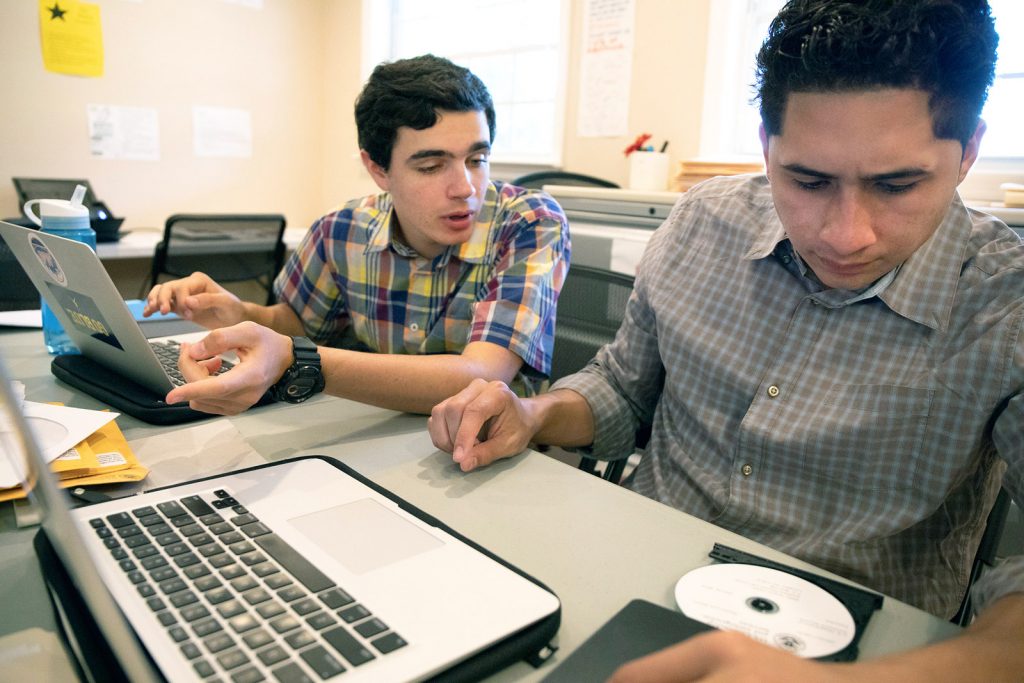
Elam Boockvar-Klein ’20 and Manny Meraz ’19
I truly cannot believe it. An international student fails a class and now may be deported. A kid just like many of my international friends at CC. He’s from Ivory Coast, just trying to go to school. You can’t even come to this country to get an education. I mean could you imagine the stress during finals week? Not just worried about getting a decent grade, but also worried about whether or not you can stay in this country. And he presented the evidence, begged the judge, showed him that he attempted the requisite number of credits, that all he wanted to do was go to school. Do you think a white student from Germany would have been detained after failing a class? Hard to believe. — Elam Boockvar-Klein ’20, Stewart Detention Center, Lumpkin
The greatest and the hardest part of this whole experience is the way in which it’s humanized a vulnerable population at the center of such a widely debated national topic. Often, we talk about issues surrounding immigration using umbrella terms, generalizing the entire group of people and implementing political and legal systems that don’t account for the diversity and complexity of the issue. But immigrants, in themselves, are diverse — they come from all over the world, they have different ages, genders, jobs, educations, backgrounds, and they each have their own story to tell. — David Eik ’19, Irwin Detention Center, Ocilla
On the morning of May 30 at around 8 a.m., G. was escorted to the waiting room for his scheduled 1 p.m. hearing. This was not the first time G. expected to have his hearing though; his first date was canceled due to the court’s scheduling mistake, and his second hearing was canceled at the end of a long day spent waiting because the judge didn’t have enough time to get to all the cases on the docket. But today, on his third scheduled hearing, the judge finally called his case three hours after the allotted time. The six of us — G., his SIFI lawyer, a SIFI employee, and we three interns — walk into the room. For just a moment, our collective power felt unstoppable. But boy, were we wrong. The courtroom is only visible through a video teleprompter, so the first few minutes of the hearing are wasted with technical adjustments; the six of us on one side, the judge and government attorney on the other. Already, it was clear that the sides of the battle had been established. The actual hearing was no different. We silently and powerlessly witnessed the judge’s bias; as he so blatantly disregarded the claims of G.’s lawyer yet vigorously took notes when it was the government’s turn to respond with a weak and utterly incorrect defense. Still though, as the decision is entirely left up to the judge’s discretion, neither the facts nor the legitimacy of G.’s claim were taken into account. The immigration judge merely restated the government’s claims and abruptly ended the hearing. — Bella Smith ’20, Folkston Detention Center, Folkston
It has officially gotten to the point where we have to specifically track what the schedule is for the guards at the detention facility because they are absolutely useless. If you get a guy who is in seg (segregation), no one else can be brought out into visitation, so you hold everyone else up. If you come at 2, it’s shift change which adds about 30 minutes/1 hour wait time. Heaven help you if you are there around 2:45, because that is when the most ridiculous thing happens at the detention center that sets you back about an hour and a half: count. All four of my teammates and I have really tried hard to work with the guards but it gets exhausting. Some are helpful and understanding of what we do, but others live to make us walk back out to our cars to put away our sunglasses, confiscate documents that we are delivering to clients, make us wait an excessive amount of time, bring us the wrong clients to the back room, chastise us for simply asking for help, and so much more. — Grace Cooke ’19, Stewart Detention Center, Lumpkin
After four days, I’m only starting to see how draining and difficult this type of work can be. I have filed away cases that had to be denied or closed for multiple reasons and seeing the sheer volume of the cases that have been denied is disappointing because it makes me realize how difficult the justice system is in the U.S. The SIFI project focuses on cases for bond and parole and is limited to those two options. … Even the cases that have been accepted by our team are emotionally draining because of the amount of work that each case takes to build a strong argument for these people. — Miguel Mendez ’19, Irwin Detention Center, Ocilla
Something that I realized during this trip was the difficulty for lawyers to take on this kind of work. Our project coordinator sent us an article about an attorney with a private practice in rural Georgia. On top of the remote location of the detention center and her potential clients, she had to dedicate a massive amount of time that were frequently rejected by the judges in Atlanta. She could not make money (much less expect to win a case),and ultimately had to leave her firm. Therefore, SIFI’s work is so important because it can count on the income of SPLC to finance its operation and employees — especially when benefits like free housing can encourage employees to dedicate their skills in remote locations and endure detention center personnel often hostile to their work. — Mark Scaggs ’18, Folkston Detention Center, Folkston
The first week was rough, but the highlight was being part of a detainee’s release and having the opportunity to listen to his story. Back in his home country, he was abused for his sexual orientation and he was also abused in the detention center. One of the volunteers who met him pushed for his release by using his network, including letters from Congress people. B. stayed with our CC group for a few days. During his visit, he spoke with us about his life and his experiences. He told me about the depression he felt during detention and that he felt like giving up, but his release was announced soon after and it gave him hope. He told me how the guards mistreated him, but that a few of the other detainees looked out for him. When he left, he gave everything to his friends in detention, some who hardly had anything or anyone to look out for them. B. gave me hope and a drive to continue doing this work for the possibility that others can also have a future. These releases rarely happen and it showed us how much it really takes. — Veronica Fernandez Diaz ’19, Stewart Detention Center, Lumpkin
*Count is when officials close down the detention center to lawyers and others while they take a head count of detainees.
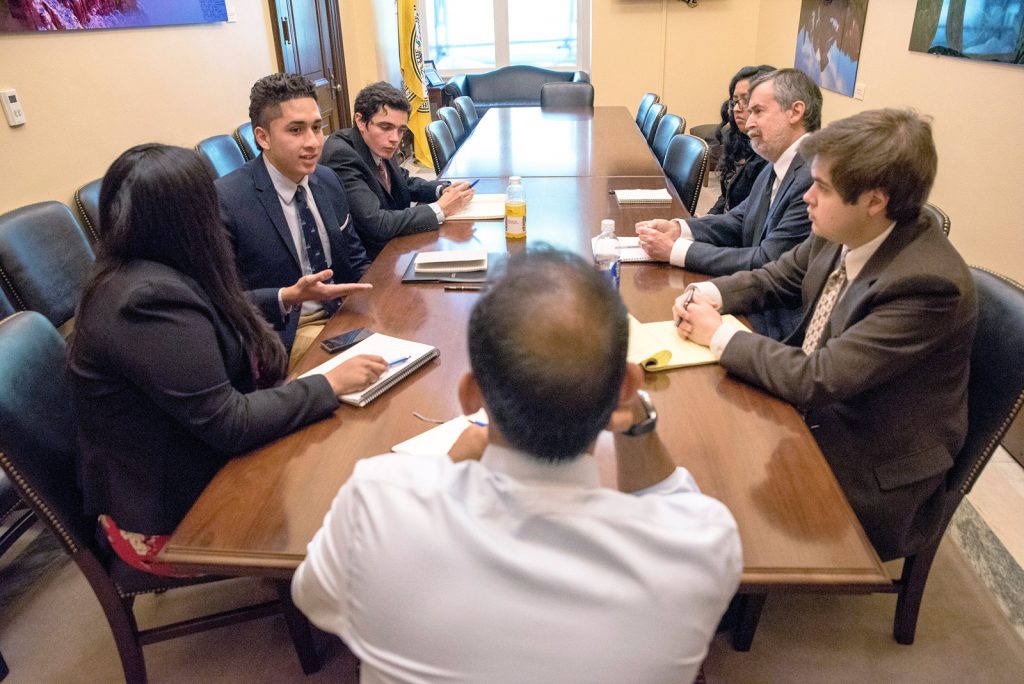
Upon returning from Georgia, several students traveled to Washington, D.C., to brief legislative aides working on immigration in the offices of Colorado Senators Michael Bennet (D) and Cory Gardner (R). Students also had the opportunity to meet with Sen. Bennet. Both senators have played a leadership role on the issue of immigration and were particularly interested in hearing about students’ experiences in the detention centers given forthcoming appropriations votes tied to expansion of immigrant detention.
